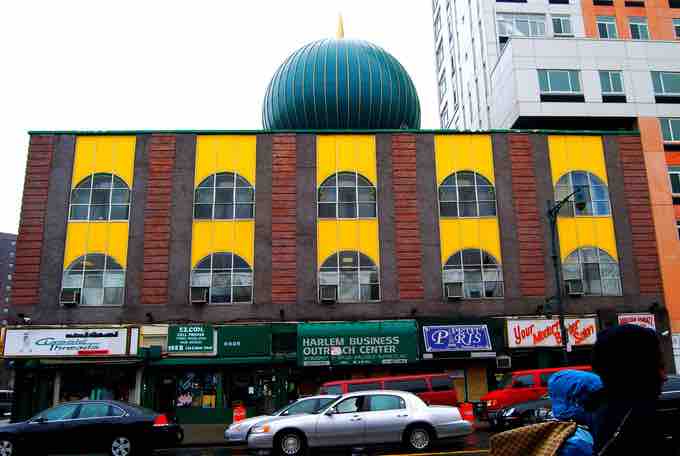Islam in the United States
Once very small, the Muslim population of the U.S. increased greatly in the 20th century, with much of the growth driven by rising immigration and conversion, and a comparatively high birth rate. In 2005, more people from Islamic countries became legal permanent United States residents than in any year in the previous two decades (nearly 96,000). In 2009, more than 115,000 Muslims became legal residents of the United States.
American Muslims come from various backgrounds, and are one of the most racially diverse religious groups in the United States according to a 2009 Gallup poll. Immigrant communities of Arab and South Asian descent make up the majority of American Muslims. Native-born American Muslims are mainly African-Americans who make up about a quarter of the total Muslim population. Many of these have converted to Islam during the last seventy years. Conversion to Islam in prison and in large urban areas has also contributed to its growth over the years.
Slavery and Islam
Many of the slaves brought to colonial America from Africa were Muslims. By 1800, some 500,000 Africans arrived in what became the United States. Historians estimate that between 15 to 30 percent of all enslaved African men, and less than 15 percent of the enslaved African women, were Muslims. These enslaved Muslims stood out from their compatriots because of their "resistance, determination, and education".
Modern Migration
Small-scale migration to the U.S. by Muslims began in 1840, with the arrival of Yemenis and Turks, and lasted until World War I. Most of the immigrants, coming from Arab areas of the Ottoman Empire, came with the purpose of making money and returning to their homeland. However, the economic hardships of 19th century America prevented them from prospering. As a result, the immigrants settled in the United States permanently. These immigrants settled primarily in Dearborn, Michigan; Quincy, Massachusetts; and Ross, North Dakota. Ross, North Dakota is the site of the first documented mosque and Muslim cemetery, but it was abandoned and later torn down in the mid-1970s. A new mosque was built in its place in 2005.
Demographics
According to the U.S. Department of State, the largest ethnic groups of American Muslims are those of South Asian, Arab and African-American descent.
There are 1,209 mosques in the United States and the nation's largest mosque, the Islamic Center of America, is in Dearborn, Michigan. It caters mainly to the Shi'a Muslim congregation; however, all Muslims may attend this mosque. It was rebuilt in 2005 to accommodate over 3,000 people for the increasing Muslim population in the region. Approximately half (50%) of the religious affiliations of Muslims is Sunni, 16% Shia, 22% non-affiliated and, 16% other/non-response. Muslims of Arab decent are mostly Sunni (56%) with minorities who are Shi'a (19%). Bangladeshis (90%), Pakistanis (72%), and Indians (82%) are mainly Sunni, while Iranians are mainly Shi'a (91%). Of African-American Muslims, 48% are Sunni, 34% are unaffiliated (mostly part of the Community of W. Deen Mohammed), 16% other (mostly Nation of Islam and Ahmadiyya) and 2% Shi'a.
Since the arrival of South Asian and Arab communities during the 1990s, there have been divisions with African Americans due to racial and cultural differences. However, since 9/11, the two groups joined together when the immigrant communities looked towards the African Americans for advice on civil rights.
Comparison to Other Religions
Islam has similarities with other American-practiced religions, including Protestantism and Christianity. Some of the similarities include a belief in a single God, who is supreme to all other gods. Many of the religious stories told in these religions share a similar thread, although certain details or the order of the story may be slightly different, depending upon the religious text it comes from. Also, these religious all believe in an afterlife, promoting good behaviors and adherence to religious doctrine in order to ensure entrance to this revered place.
American Islamic Culture
Muslims in the United States have increasingly contributed to American culture; there are various Muslim comedy groups, rap groups, Scout troops and magazines.
Some Muslims in the U.S. are also adherents of certain global movements within Islam such as the Salafi, the Muslim Brotherhood, the Gulen Movement, and the Tablighi Jamaat.
Muslim Integration into American Society
Unlike many Muslims in Europe, American Muslims do not tend to feel marginalized or isolated from political participation. Several organizations were formed by the American Muslim community to serve as 'critical consultants' on U.S. policy regarding Iraq and Afghanistan. Other groups have worked with law enforcement agencies to point out Muslims within the United States that they suspect of fostering 'intolerant attitudes'. Still others have worked to invite interfaith dialogue to improve relations between Muslim and non-Muslim Americans.
A Pew report released in 2009 noted that nearly six-in-ten American adults see Muslims as being subject to discrimination, more than Mormons, Atheists, or Jews. While Muslims comprise less than two percent of the American population, they accounted for approximately one quarter of the religious discrimination claims filed with the Equal Employment Opportunity Commission during 2009.

Masjid Malcolm Shabazz Mosque
Mosque in New York City.